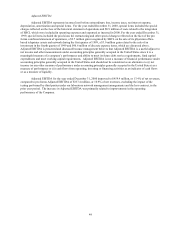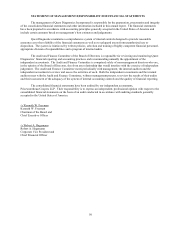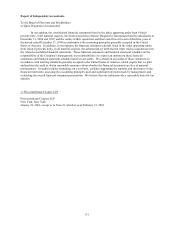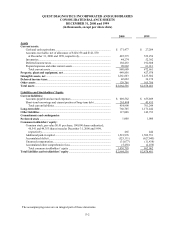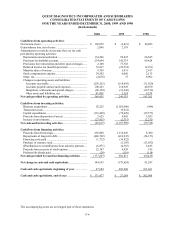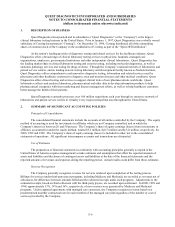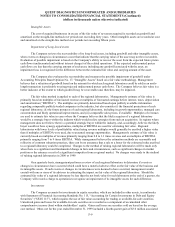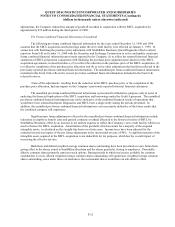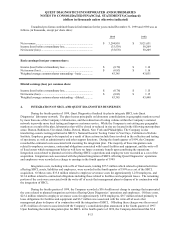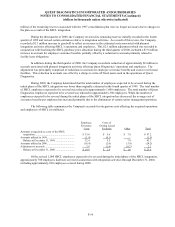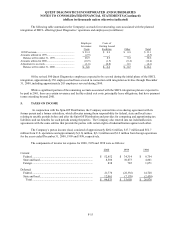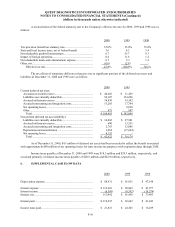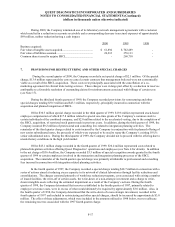Quest Diagnostics 2000 Annual Report Download - page 79
Download and view the complete annual report
Please find page 79 of the 2000 Quest Diagnostics annual report below. You can navigate through the pages in the report by either clicking on the pages listed below, or by using the keyword search tool below to find specific information within the annual report.QUEST DIAGNOSTICS INCORPORATED AND SUBSIDIARIES
NOTES TO CONSOLIDATED FINANCIAL STATEMENTS (Continued)
(dollars in thousands unless otherwise indicated)
F-9
Intangible Assets
The cost of acquired businesses in excess of the fair value of net assets acquired is recorded as goodwill and
amortized on the straight-line method over periods not exceeding forty years. Other intangible assets are recorded at cost
and amortized on the straight-line method over periods not exceeding fifteen years.
Impairment of Long-Lived Assets
The Company reviews the recoverability of its long-lived assets, including goodwill and other intangible assets,
when events or changes in circumstances occur that indicate that the carrying value of the asset may not be recoverable.
Evaluation of possible impairment is based on the Company's ability to recover the asset from the expected future pretax
cash flows (undiscounted and without interest charges) of the related operations. If the expected undiscounted pretax
cash flows are less than the carrying amount of such asset, including any goodwill associated with the asset, an
impairment loss is recognized for the difference between the estimated fair value and carrying amount of the asset.
The Company also evaluates the recoverability and measures the possible impairment of goodwill under
Accounting Principles Board Opinion No. 17, “Intangible Assets” based on a fair value methodology. Management
believes that a valuation of goodwill based on the amount for which each regional laboratory could be sold in an arm's-
length transaction is preferable to using projected undiscounted pretax cash flows. The Company believes fair value is a
better indicator of the extent to which goodwill may be recoverable and, therefore, may be impaired.
The fair value method is applied to each of the regional laboratories. Management's estimate of fair value is
primarily based on multiples of forecasted revenue or multiples of forecasted earnings before interest, taxes, depreciation
and amortization (“EBITDA”). The multiples are primarily determined based upon publicly available information
regarding comparable publicly-traded companies in the industry, but also consider (i) the financial projections of each
regional laboratory, (ii) the future prospects of each regional laboratory, including its growth opportunities, managed care
concentration and likely operational improvements, and (iii) comparable sales prices, if available. Multiples of revenues
are used to estimate fair value in cases where the Company believes that the likely acquirer of a regional laboratory
would be a strategic buyer within the industry which would realize synergies from such an acquisition. In regions where
management does not believe there is a potential strategic buyer within the industry, and, accordingly, believes the likely
buyer would not have synergy opportunities, multiples of EBITDA are used for estimating fair value. Regional
laboratories with lower levels of profitability valued using revenue multiples would generally be ascribed a higher value
than if multiples of EBITDA were used, due to assumed synergy opportunities. Management's estimate of fair value is
currently based on multiples of revenue primarily ranging from 0.8 to 1.1 times revenue and on multiples of EBITDA
primarily ranging from 7 to 9 times EBITDA. While management believes the estimation methods are reasonable and
reflective of common valuation practices, there can be no assurance that a sale to a buyer for the estimated value ascribed
to a regional laboratory could be completed. Changes to the method of valuing regional laboratories will be made only
when there is a significant and fundamental change in facts and circumstances, such as significant changes in market
position or the entrance or exit of a significant competitor from a regional market. No changes were made to the method
of valuing regional laboratories in 2000 or 1999.
On a quarterly basis, management performs a review of each regional laboratory to determine if events or
changes in circumstances have occurred which could have a material adverse effect on the fair value of the business and
its intangible assets. If such events or changes in circumstances were deemed to have occurred, management would
consult with one or more of its advisors in estimating the impact on fair value of the regional laboratory. Should the
estimated fair value of a regional laboratory be less than the net book value for such laboratory at the end of a quarter, the
Company will record a charge to operations to recognize an impairment of its intangible assets for such difference.
Investments
The Company accounts for investments in equity securities, which are included in other assets, in conformity
with Statement of Financial Accounting Standards No. 115, “Accounting for Certain Investments in Debt and Equity
Securities” (“SFAS 115”), which requires the use of fair value accounting for trading or available-for-sale securities.
Unrealized gains and losses for available-for-sale securities are recorded as a component of accumulated other
comprehensive income (loss) within stockholders’ equity. Gains and losses on securities sold are based on the average
cost method. Other, net for the year ended December 31, 1999 included a fourth quarter gain of $3.0 million associated


